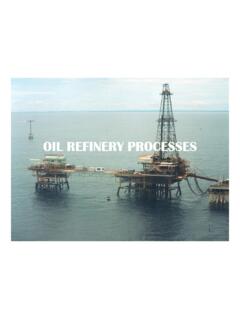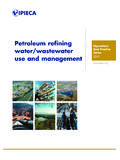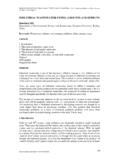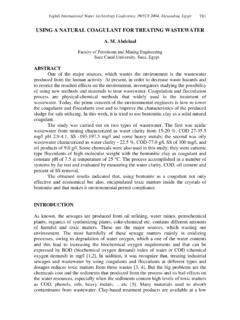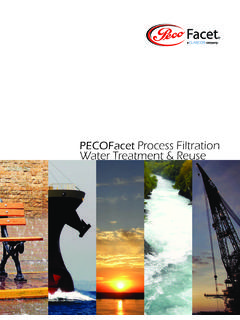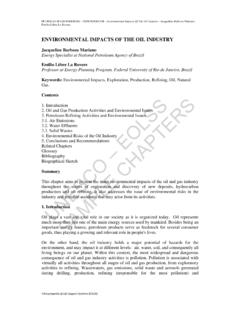Transcription of OIL REFINERY PROCESSES - University of Mohaghegh Ardabili
1 OIL REFINERY PROCESSESOIL REFINERY PROCESSESOIL REFINERY PROCESSESOIL REFINERY PROCESSES1 World Crude Oil RefineriesSource: #importRefining operationsPetroleum refining PROCESSES and operations can be separated into five basic areas: Fractionation(distillation) is the separation of crude oil in atmospheric and vacuum distillation towers into groups of hydrocarbon compounds of differing boiling-point ranges called "fractions" or "cuts." Conversion Processeschange the size and/or structure of hydrocarbon molecules. These PROCESSES include: : Decomposition(dividing) by thermal and catalytic cracking; 3 Decomposition(dividing) by thermal and catalytic cracking; Unification(combining) through alkylation and polymerization; and Alteration(rearranging) with isomerization and catalytic reforming.
2 Treatment Processesto prepare hydrocarbon streams for additional processing and to prepare finished products. Treatment may include removal or separation of aromatics and naphthenes, impurities and undesirable contaminants. Treatment may involve chemical or physical separation , absorption, or precipitation using a variety and combination of PROCESSES including desalting, drying, hydrodesulfurizing, solvent refining , sweetening, solvent extraction, and solvent dewaxing. refining operations Formulating and Blendingis the process of mixing and combining hydrocarbon fractions, additives, and other components to produce finished products with specific performance properties.
3 Other refining Operationsinclude:4 Other refining Operationsinclude: light-ends recovery; sour-water stripping; solid waste, process-water and wastewater treatment; cooling, storage and handling and product movement; hydrogen production; acid and tail-gas treatment; and sulfur recovery. Modern petroleum ProcessingSeven Basic Operations in petroleum Processing5 Physical and chemical processesPhysicalChemicalThermalCatalyti cDistillationSolvent extractionPropane deasphaltingVisbreakingDelayed cokingFlexicokingHydrotreatingCatalytic reformingCatalytic cracking6 Propane deasphaltingSolvent dewaxingBlendingFlexicokingCatalytic crackingHydrocrackingCatalytic dewaxingAlkylationPolymerizationIsomeriz ationTypical layout for an oil refinery7 PETROCHEMICAL PRODUCT TREEO lefinsButadienePropyleneEthyleneIsopropy l Alcohol/ AcetoneEO/EGEDC2 Ethyl
4 HexanolAcrylonitrileP V CAcrylic FiberGlycol Ethers EnthaloaminesPolyethylene (Ld/Hd)A B S PlasticsP B RPlasticisersPolypropyleneDye Stuff and Chemicals IntermediateBuilding BlockIntermediateDownstream ProductsEDC -Ethylene dichlorideEO -Ethylene oxideEG -Ethylene glycolDMT -Dimethyl terephathalatePVC -Polyvinyl chloridePBR -Polybutadiene rubberSBR -Styrene butadiene rubberNaphthaOlefinsAromaticsXyleneBenze neButadieneCyclohexane/ CaprolactumCumene/PhenolPhthalic AnhydrideMaleic AnhydrideDetergents AlkylateD M TP B RS B RThermoset ResinsAlkyd ResinsPlasticisersNylonPolyesterPolyeste r IndustryIn general.
5 The products whichdictaterefinerydesignarerelatively few in number, andthe basic REFINERY PROCESSES arebased onthe large-quantityproductssuchasgasoline,pro ductssuchasgasoline,diesel,jetfuel,andho meheating Crude oil distillation is more complicated than product distillation, in part because crude oils contain water, salts, and suspended solids. Step 1in the refining process is to remove these contaminants so as to reduce corrosion, plugging, and fouling of equipment and to prevent poisoning catalysts in processing units. Step 2 most typical methods of crude-oil desaltingare chemicaland electrostatic separation, and both use hot water as the extraction agent.
6 In chemical desalting, water and chemical surfactant(demulsifiers) are added to the crude, which is heated so that salts and other 11are added to the crude, which is heated so that salts and other impurities dissolve or attach to the water, then held in a tank to settle out. Electrical desalting is the application of high-voltage electrostatic charges to concentrate suspended water globules in the bottom of the settling tank. Surfactants are added only when the crude has a large amount of suspended solids. Step 3(and rare) process filters hot crude using diatomaceous earth.
7 The salts are dissolved in the wash water and the oil and water phases separated in a settling vessel either by adding chemicals to assist in breaking the emulsion or by developing a high-potential electrical field across the settling vessel to coalesce the droplets of salty water more rapidly. Either AC or DC fields may be used and potentials from 12,000 to 35,000 volts are used to promote coalescence. For single-stage desalting units 90 to 95% efficiencies are obtained and two-stage PROCESSES achieve 99% or better If the pH of the brine exceeds 7, emulsions can be formed because of the sodium naphthenate and sodium sulfide Present.
8 For most crude oils it is desirable to keep the pH below Better dehydration is obtained in electrical desalters when they are operated in the pH range of 6 to 8 with the best dehydration obtained at a pH near 6. The pH value is controlled by using another water source or by the addition of acid to the inlet or recycled The crude oil feedstock is heated to 65-180 C to reduce viscosity and surface tensionfor easier mixing and separation of the water. The temperature is limited by the vapor pressure of the crude-oil feedstock. In both methods other chemicals may be added.
9 Ammonia is often used to reduce corrosion. Caustic or acid may be added to adjust the pH of the water Wastewater and contaminants are discharged from the bottom of the settling tank to the wastewater treatment stage electrostatic desalting systems14 Two-stage electrostatic desalting systems15 Desalting/dehydration16 Industrial process furnaces17 Fuel flows into the burner and is burnt with air provided from anair blower. There can be more than one burner in a particularfurnace which can be arranged in cells which heat a particular setof tubes.
10 Burners can also be floor mounted, wall mounted or roof mounteddepending on design. The flames heat up the tubes, which in turn heat the fluid inside inthe first part of the furnace known as the radiant section or firebox. The heating fluid passes through the tubes and is thus heated to The gases from the combustion are known as flue gas. After theflue gas leaves the firebox, most furnace designs include aconvection section where more heat is recovered before venting tothe atmosphere through the flue gas stack.
